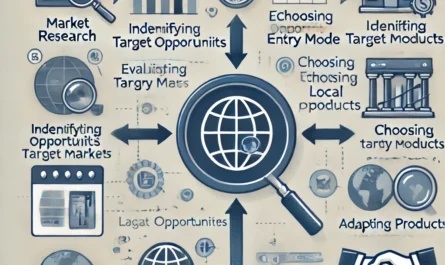Businesses today are operating in an environment where data is more valuable than ever. As the digital landscape continues to evolve, companies are increasingly looking to data to drive decision-making processes, create more personalized customer experiences, and streamline operations. In this article, we will explore how to build a data-driven business strategy that empowers better decision-making and sustainable growth.
A well-designed data-driven strategy not only helps in making more informed decisions but also equips businesses with the agility and foresight to respond to market changes and emerging trends. Let’s dive into how you can effectively develop such a strategy.
Understanding a Data-Driven Business Strategy
What is a Data-Driven Strategy?
A data-driven business strategy is a strategic approach where business decisions and actions are guided by data insights. Rather than relying on intuition or historical patterns alone, companies leverage data—whether customer behavior analytics, market trends, or performance metrics—to shape their strategy. By using data, organizations can uncover patterns, predict future trends, and make smarter, evidence-based decisions.
Why Businesses Need Data-Driven Approaches
The sheer volume of data generated today, from digital transactions to customer interactions, is overwhelming. Businesses that successfully tap into this data are able to outpace competitors who rely solely on traditional methods. A data-driven strategy helps companies:
- Stay ahead of market trends
- Understand customer needs in real-time
- Optimize resources for better efficiency
- Improve their decision-making process
With data at their core, organizations can make informed decisions that are more likely to yield positive results and mitigate potential risks.
Benefits of a Data-Driven Business Strategy
Improved Decision-Making
One of the main advantages of a data-driven strategy is the ability to make decisions based on solid evidence. Instead of relying on guesswork or past experiences, companies use real-time data to make predictions and decisions that are more accurate and relevant. This results in higher confidence in decision-making, quicker responses to market demands, and fewer costly mistakes.
Greater Efficiency
When businesses are guided by data, they can streamline processes, identify bottlenecks, and optimize resource allocation. Data insights can help highlight inefficiencies within the organization, allowing businesses to make adjustments that improve productivity. Whether it’s automating certain tasks or reallocating resources, data ensures that business operations run smoothly.
Better Customer Insights
In a world where customer expectations are higher than ever, understanding customer behavior is critical. A data-driven approach allows businesses to gain deeper insights into customer preferences, buying patterns, and behavior. This enables companies to personalize their marketing efforts, offer tailored services, and ultimately improve customer satisfaction.
The Role of Data in Decision-Making
Data as a Key Resource
Data has become one of the most valuable resources for businesses in the 21st century. Companies with the ability to effectively capture, store, and analyze data are at a significant advantage over those who cannot. The right data can offer insights into virtually every aspect of a business, from employee productivity to customer satisfaction and market demand.
Enhancing Business Agility
Data-driven companies are more agile because they can quickly respond to market shifts and customer preferences. By continuously monitoring key metrics, businesses can detect patterns that indicate an opportunity or a potential issue. This allows them to pivot strategies or processes in real-time, ensuring they remain competitive and relevant in fast-paced markets.
Reducing Risk
Every business decision comes with some level of risk. However, data-driven companies can significantly reduce uncertainty by relying on predictive analytics. This allows them to anticipate potential outcomes and make more informed decisions that reduce the likelihood of failure. Data analytics helps businesses assess risk factors more comprehensively and develop strategies to mitigate them.
Identifying Key Data Sources for Your Business
Internal vs. External Data
There are two main types of data sources that businesses can leverage: internal and external. Internal data includes information gathered from within the organization, such as sales records, employee performance metrics, and operational data. External data, on the other hand, comes from outside the organization and may include market research, customer demographics, and competitive analysis. Both types of data are crucial in building a well-rounded, data-driven strategy.
Leveraging Big Data
Big data refers to the large volumes of structured and unstructured data generated by businesses every day. It’s critical to have the tools and expertise to manage, analyze, and extract value from this data. By leveraging big data, businesses can identify trends, optimize their operations, and make better decisions faster. Big data technologies can also support advanced analytics such as machine learning and artificial intelligence, which we’ll discuss later.
Importance of Real-Time Data
In today’s fast-paced environment, real-time data is essential for businesses that need to make quick, informed decisions. Unlike static reports, real-time data offers up-to-the-minute information that reflects the current state of the business. Companies that rely on real-time data can act on insights more swiftly, whether they’re adjusting marketing strategies or managing supply chain operations.
You can also read; How to Identify New Market Opportunities for Business Growth
Building a Data-Centric Culture
Encouraging Data Literacy
A data-driven strategy is only as effective as the people using it. Data literacy—understanding how to interpret and use data—is crucial to fostering a data-driven culture. Employees across all departments should be trained to comprehend and analyze the data relevant to their roles. This ensures that the entire organization can contribute to data-driven decision-making.
Shifting to Data-First Thinking
For a business to fully benefit from data-driven strategies, it must adopt a data-first mentality. This means that all decisions, whether they’re related to marketing, product development, or operations, should be grounded in data. A data-first approach encourages teams to seek evidence before making decisions and to continually evaluate performance through the lens of data.
Breaking Down Silos
A common challenge in building a data-driven culture is the presence of silos, where different departments operate independently of one another. This can limit the flow of data and insights across the organization. By breaking down these silos and promoting collaboration, businesses can ensure that data is shared and leveraged more effectively across all teams.



